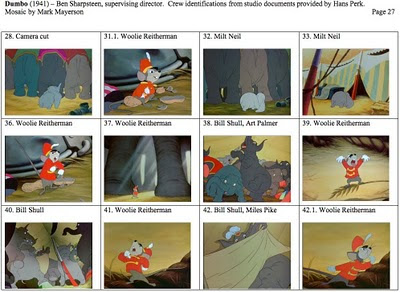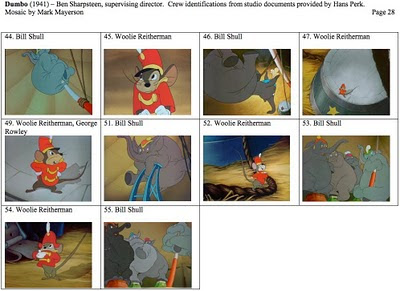


 This sequence begins with Mrs. Jumbo and Dumbo both sadly swaying to the music. Though separated by space, their mirror actions show that their feelings are the same; they are depressed due to their separation.
This sequence begins with Mrs. Jumbo and Dumbo both sadly swaying to the music. Though separated by space, their mirror actions show that their feelings are the same; they are depressed due to their separation.While Bill Tytla is justifiably celebrated for certain scenes in this film, particularly Dumbo's bath and the "Baby Mine" section, he doesn't receive enough attention for the other elephants. Within this film, he shows an enormous range of acting, portraying both heroes and villains, innocence and repulsiveness. The four antagonist elephants are self-righteous, insensitive and cruel. Tytla works both sides of the street, so to speak, stressing Dumbo's appeal while also showing how repellent the other elephants are. It's this combination that creates the film's emotional impact.
Because Dumbo is unjustly vilified, we immediately like Timothy for sticking up for him. His scaring the elephants is emotionally satisfying as it deflates their pride and superiority. The fact that someone so small can triumph over others so large is a foreshadowing of Dumbo's eventual success.

Timothy is voiced by Ed Brophy, an actor whose film career spanned 1920 to 1960. The earliest film I've seen him in is Buster Keaton's The Cameraman (1928) and the latest is John Ford's The Last Hurrah (1958). Brophy typically played urban wise-guys or detectives. Timothy is a different kind of role for Brophy, as it is warm and sentimental, not his typical persona.
It's interesting that Disney repeatedly used some voices over the years (Verna Felton and Sterling Holloway in this film went on to do many others) but some, like Brophy, were never used again. It's a shame, as I think that Timothy is one of Brophy's best roles and his voice was certainly distinctive and flexible enough to inspire some great animation.
Woolie Reitherman's Timothy is more solid and structural than Fred Moore's (who doesn't appear until later in the film). Reitherman has some nice business with the peanut (why no sound effect when the shell cracks in shot 8.1?), and Timothy's scare tactics are fairly reserved, better to contrast with the wild fear they inspire. Bill Shull's animation of the panic-stricken elephants in shot 38 is excellent.
I was aware that Ben Sharpsteen did some last minute editing on this film and I always assumed that the jump cut between shots 32 and 33 was the result of that. I was surprised to see on the draft that these shots were never separated by a cut away to something else. I wonder if the end of 32 or the start of 33 was truncated to speed up Dumbo's exit. I find it hard to believe that a cut this bad was intended.
(Michael Sporn has posted a Bill Tytla Dumbo run here.)



3 comments:
I really like Woolie Reitherman's work on films, and I really like his Timothy Mouse work, its a shame that his work only appears in two sequences, and he doesn't seem to do a lot!!
I love Bill Tytla's animation here. It shows that he was capable of more than big, broad characters. His animation shows precise characterization (which is definitely helped by the strong story, as nothing is created in a vacuum). It's a shame that scenes like these don't come up in other discussions about him.
Wolfgang Reitherman shares Bill Tytla's general reputation for drawing big powerful characters, though they also did small characters. Reitherman animated Jiminy Cricket for much of Pinocchio's second half.
Incidentally, Timothy shares a similar role for Dumbo as Jiminy did for Pinocchio.
Post a Comment